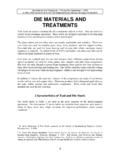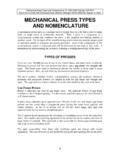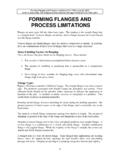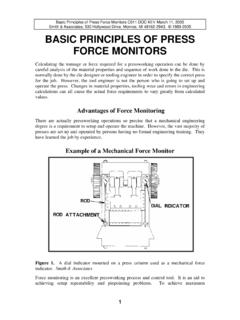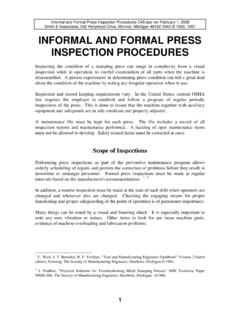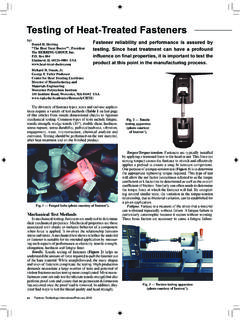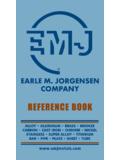Transcription of Troubleshooting Cutting and Punching - Smith & …
1 Troubleshooting Punching and Cutting Operations D01 rev March 12, 2006 Smith & Associates, 530 Hollywood Drive, Monroe, Michigan 48162-2943 1993, 2006 Troubleshooting Punching AND Cutting OPERATIONS Cutting , which includes shearing, is the most common pressworking operation. A single formed stamping such as a sieve or automobile inner door has many holes, all of which are produced by Cutting operations. In the case of the sieve, which has many holes in a regular pattern, the process may be referred to as perforating. However, in each example, the same Cutting process employed to produce a single hole is used. The repair and Troubleshooting of Cutting dies is a very important die repair skill. The work varies from maintaining simple hole Punching dies to complex progressive and transfer dies performing many metal forming operations in addition to Cutting and shearing.
2 Understanding Important Concepts and Skills Effective die maintenance starts with the die designer. If the die is designed correctly it will work correctly and require infrequent repairs that are simple. This chapter starts with the basics that all diemakers and designers most likely understand. However, this book serves as a reference for persons starting in the trade as well as experienced workers including engineers. It must serve the needs of the apprentice and trainee as well as those with decades in the trade as a source of information to solve problems. A B Figure 1. Sectional views of a Cutting die (A) for producing a round hole. The punch is compressed (B) after making initial contact with the stock.
3 Smith & Associates 1 Troubleshooting Punching and Cutting Operations D01 rev March 12, 2006 Smith & Associates, 530 Hollywood Drive, Monroe, Michigan 48162-2943 1993, 2006 Example of a Simple Die for Punching A Round Hole Figure 1A illustrates a sectional view of a simple die for Punching a hole in a part. Such dies may have several punches. In addition, a cut off shearing operation may be included if the die is fed with strip or coil stock. The punch is fastened to the upper die shoe by means of a retainer having a hardened backing plate. A slug can be seen falling through the lower die shoe. On the upstroke of the press, the stock is stripped from the punch by a simple fixed or tunnel stripper. As the press and die close, the punch or punches first make contact with the stock.
4 Exactly what occurs following the moment of initial contact of the punch on the stock varies based on: 1. The speed and mass of the press ram or slide. 2. The thickness and hardness of the stock. 3. The force required initiating yielding of the stock. Initial Contact of Punch on Stock Figure 1B illustrates a punch making initial contact with the stock. As the die closes, a compressive strain (2A) stores energy within the punch body. This is like compressing a spring. Cutting operations are essentially a controlled process of plastic deformation or yielding of the material, leading to fracture. Both tensile and compressive strains are involved. Bending or distortion of the scrap metal trimmed away, slugs and in some cases, the part itself may occur.
5 A B C Figure 2. Compressive strain (A) is developed in the punch as the die closes. Once the force developed by the closure of the press and transmitted through the punch (B) equals the yield point of the stock, plastic deformation (C) starts occurring. Smith & Associates 2 Troubleshooting Punching and Cutting Operations D01 rev March 12, 2006 Smith & Associates, 530 Hollywood Drive, Monroe, Michigan 48162-2943 1993, 2006 Simplified Sequence of Operations As the press closes, the punch remains in contact with the stock until the force transmitted through the punch is great enough to exceed the shear strength of the material. The material continues to yield (3A) until complete fracture occurs.
6 Next, the compressive strain in the punch releases and the slug pushed completely into the die opening (3B) at the bottom of the press stroke. A B Figure 3. The stock continues to yield (A) until complete fracture occurs. Next, the slug is pushed into the die opening (B) at the bottom of the press stroke. Smith & Associates Slug Discharge Most slugs fall into the die opening by gravity as shown in (4A). If this does not occur, there are a number of means available to the die designer and diemaker to assure proper slug discharge. The final step is the withdrawal of the punch from the stock (4A) on the press upstroke. Figure (1A) shows tunnel or fixed stripper. Tunnel strippers have the advantage of simplicity and are adequate for many applications.
7 However, spring loaded strippers are often required to provide precise stock control of the Cutting process. Roughness of Fracture Plastic deformation of the material occurs throughout the Cutting process. Cutting involves a controlled failure of the material. The fractured portion of the edge will be somewhat rough due the tearing action that occurs. In thick materials, this roughness may be quite pronounced. Applying the term fracture to metal Cutting operations is easily misunderstood. The fracture is seldom a sudden parting of the material. For example, when Cutting low carbon steels such as SAE-AISI 1005 to 1008 the fracture is a plastic deformation of the material in which the stock is torn apart. Cutting also involves a controlled tensile failure of the material.
8 The fractured portion of the edge will be somewhat rough due to the tearing action that occurs. In thick materials, this roughness may be quite pronounced. 3 Troubleshooting Punching and Cutting Operations D01 rev March 12, 2006 Smith & Associates, 530 Hollywood Drive, Monroe, Michigan 48162-2943 1993, 2006 A B Figure 4. The slug falls into the die opening (A) at the bottom of stroke. Finally, the punch is withdrawn (B). Smith & Associates How Die Clearance Affects Cutting Operations Clearance Required for Various Operations There are no absolute rules governing the amount of clearance between the punch and die. This clearance is normally expressed as a percentage of stock thickness per side.
9 For mild steel, the clearance per side varies between five and twelve percent of stock thickness. In general, tight clearances will result in holes having a high ratio of shear or burnish to fracture and less taper at the expense of accelerated tooling wear. A B Figure 5. Normal clearance (A) results in approximately one-third shear. Very large clearances (B) result in excessive die-roll, excessive burr height, and a large tapered fracture. Smith & Associates 4 Troubleshooting Punching and Cutting Operations D01 rev March 12, 2006 Smith & Associates, 530 Hollywood Drive, Monroe, Michigan 48162-2943 1993, 2006 Figure (5A) illustrates a sectional view of a punch, die, stock and fractured slug where normal clearance is being used.
10 Normal clearance typically results in one-third burnish and two-thirds fracture. Excessive clearance (5B) may result in die-roll at the point of punch entry and a large burr on the underside of the part. There is very little shear or burnish. The fracture is rough as well as having a large taper on the cut edge. Roughness of Fracture The fracture, which starts from each side, may not meet evenly. One or more sharp projections may result. Optimizing the amount of die clearance to best suit the material being cut, may require some experimentation to minimize an uneven fractured edge condition. By increasing clearance, within reasonable limits, Cutting pressure is lowered, extending tool life. A limiting factor is the amount of taper permitted in the hole and the allowable burr height.
